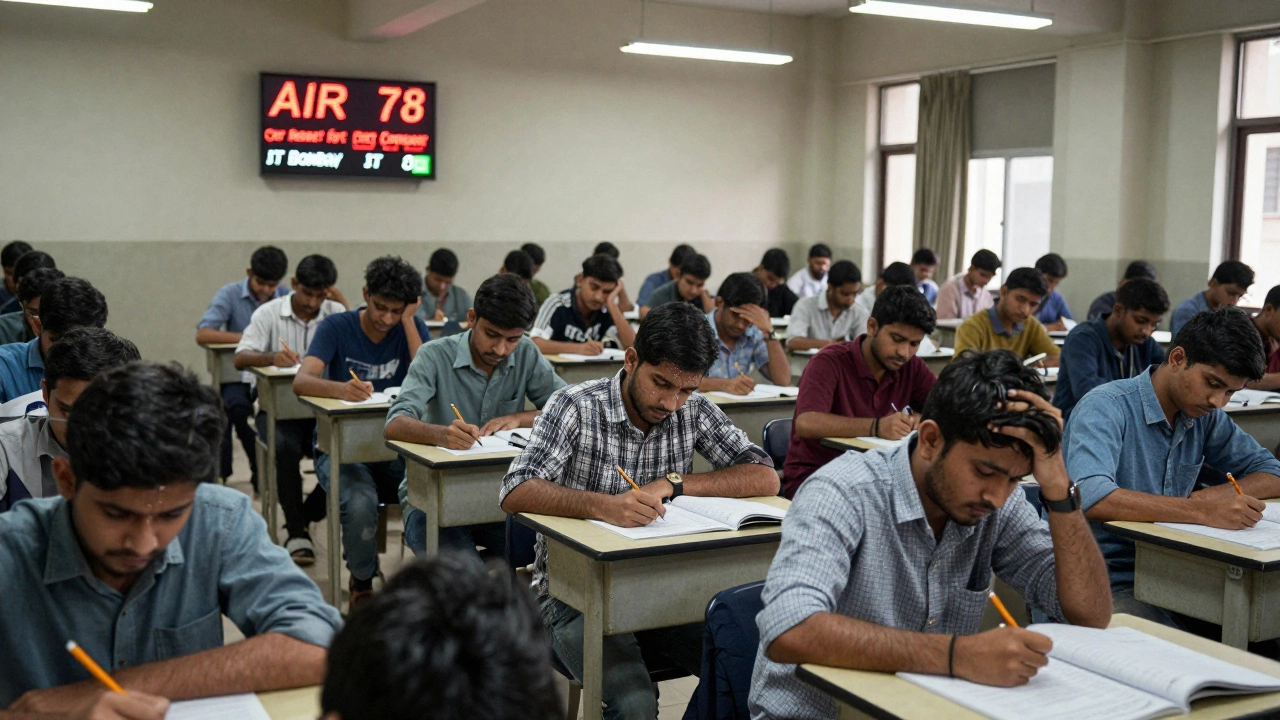Try picturing this: there's a crowd of nearly two lakh students all gunning for a few thousand seats, and everyone wants a piece of the Indian Institute of Technology pie. It isn't just about bragging rights anymore. IITs mean life-changing opportunities—better placements, cool research, global exposure, and frankly, some mad respect. Here's the catch: the first question every JEE aspirant (and their sleepless parents) asks is, "What rank is actually needed to get into IIT?" Honestly, it feels like a moving target with all the categories, quotas, branches, and shifting cut-offs. Missing the mark by even a dozen ranks can mean the difference between Computer Science and, well, crying in your room.
Breaking Down the JEE Advanced: How Ranks Work
Let me tell you, cracking the JEE Advanced is no joke. Every year, close to 1.5 to 2 lakh earnest, sleep-deprived teens sit for JEE Advanced. Out of those, only around 16,000 to 18,000 manage to secure a seat somewhere in the IIT system. The selection funnel? Brutal. Your IIT cut off ranks are determined by your performance in JEE Advanced—not JEE Main. To even write this exam, you need to make the top 2.5 lakh ranks (including all categories) in JEE Main. Then, the real battle begins.
There are several key numbers you need to watch out for every year: the total number of seats, the reservation quotas, and the cut-off for each branch and IIT. IIT Bombay Computer Science? That's about the Mount Everest of Indian entrance exams. In 2024, General category cut off for IIT Bombay CSE closed at an AIR (All India Rank) around 65. For other IITs or branches, the closing ranks stretch into the thousands. Here's where it gets interesting: each IIT and each program declares its own closing ranks, which are also divided by category (General, OBC, EWS, SC, ST) and, in some cases, gender (supernumerary seats for females have their own cut-offs!).
Look at this data from recent years (sample closing ranks; actuals update every cycle):
| IIT | Branch | General Closing Rank | OBC Closing Rank | SC Closing Rank |
|---|---|---|---|---|
| IIT Bombay | Computer Science | 65 | 37 | 17 |
| IIT Delhi | Electrical Engineering | 553 | 324 | 143 |
| IIT Madras | Mechanical Eng | 1722 | 872 | 309 |
| IIT Kharagpur | Civil Eng | 3749 | 1405 | 760 |
| IIT Roorkee | Architecture | 9421 | 3552 | 1814 |
See how that plays out? Every branch and campus has its own demand, so the rank needed for IIT varies wildly depending on what you want to study and where.
Cut-Offs, Quotas, and Seat Matrix: The Real Numbers
Let’s get real about the numbers. The IITs together offer roughly 17,385 undergraduate seats in 2025, but that includes all branches, all categories, and even new IITs you may never have heard of. People obsess over Bombay, Delhi, Kanpur, Chennai, but there are newer IITs in Jammu, Bhilai, Dharwad, and so on. They might have closing ranks around or even beyond 10,000 for some branches like Civil or Metallurgy in reserved categories.
What does category do to the cut-offs? A lot. For General category, just getting into any IIT for any branch typically requires a JEE Advanced AIR below 14,000. OBC, EWS, SC, ST, and PwD quotas mean lower cut-offs, sometimes significantly so—SC candidates, for example, have gotten seats in newer IITs with ranks as high as 7000+. Supernumerary female seats (to boost gender diversity) lower the bar a bit for girls, which, by the way, is making those lists even more competitive now as more girls aim IIT-high.
Here's a table showing seat distribution and quotas (2025 estimates):
| Category | Percentage of Seats Reserved | Approx. Seat Count |
|---|---|---|
| General/Open | 40.5% | 7041 |
| OBC-NCL | 27% | 4694 |
| SC | 15% | 2608 |
| ST | 7.5% | 1304 |
| EWS | 10% | 1738 |
| PwD (across categories) | 5% (within category) | 890 |
Don’t just chase the closing cut-off; understand what branch and campus really suit your goals. There’s no one-size-fits-all answer. For instance, a top electronics program at a newer IIT can be miles better for some career paths than a less-popular stream at a top campus.

Trends and Surprises: How Ranks Change Year to Year
Every year, someone thinks they’re perfectly safe, then bang, the cut-off jumps a few hundred spots and it’s heartbreak. There’s a reason: cut-offs don’t just depend on how tough the exam was. They’re shaped by last-minute choices, special preferences for certain branches, even trends like AI and Data Science becoming the new favorites while traditional Civil Engineering sees lower demand.
Covid years shook things up; in 2021, lower board marks eligibility meant more people could take JEE. In 2023 and 2024, some new IITs added programs, creating fresh seats and slightly lowering overall closing ranks. But top five IITs? If anything, they’re more brutal because kids are smarter, and coaching is getting more intense every year.
There’s also a wildcard effect—the fear of branch sliding. Many aim for less-crowded branches, planning to switch after first year, but this is never a guarantee. Most IITs have strict branch change policies—it often means topping your class in first year, and that’s another rat race.
Another thing: Overseas Citizens of India (OCI) candidates really felt the heat after policy changes. From 2021 onwards, they’re treated as foreigners—sometimes making things tougher. Foreign nationals? They have super-limited seats and sky-high fee structures; the ranks don’t apply the same way for them.
Smart Tips for Cracking the IIT Cut-Off Game
First, research the last three years’ cut-off data for both program and campus. Don’t blindly follow last year’s closing rank, especially if you’re close to the line. Look for trends—if Computer Science saw a closing at 850 in 2023 but at 820 in 2024, you’ll likely need to be even higher in 2025.
Next, tweak your preferences smartly during JoSAA counseling. Sometimes just shifting your preferred branch or considering another campus with a solid peer group can make the world of difference. Also, check branch reputation versus just the IIT’s reputation—Electrical in Guwahati might put you ahead of a less-in-demand branch in the top three.
Mock counseling tools and cut-off predictors are pretty useful, but your best bet is talking to students at your dream IIT or joining authentic Telegram groups where people share real-time stats. Also, don’t compromise your choices too fast—wait lists can move a lot as kids shuffle seats through multiple JOSA counseling rounds.
If you’re an OBC, EWS, or female candidate, make sure you’ve uploaded all the right certificates—lots of people lose out because their docs aren’t in order at the crunch moment. And if you’re from a PwD background, look out for special seat allocation; IITs offer extra help, including scribe and support, and often the cut-off is lower.
- Study the previous years’ ranks but apply wide—branch and location both.
- Don’t bank on branch change—it’s a gamble.
- Have your category certificates and docs ready; annual renewals can trip you up.
- If possible, try talking to IIT alumni—they can share trade secrets on campus life and branch scope that Google won’t.
- Always enter as many choices as you genuinely want in JoSAA, not just a few.
- Sleep well before the exam—seriously. People have blanked out after all-nighters.
So, what’s the magic number? The honest answer is, it depends on your dream branch, campus, and category. But knowing the data, the real trends, and playing the counseling game smart can get you much closer to your IIT dream than simply stressing over a target rank.









0 Comments